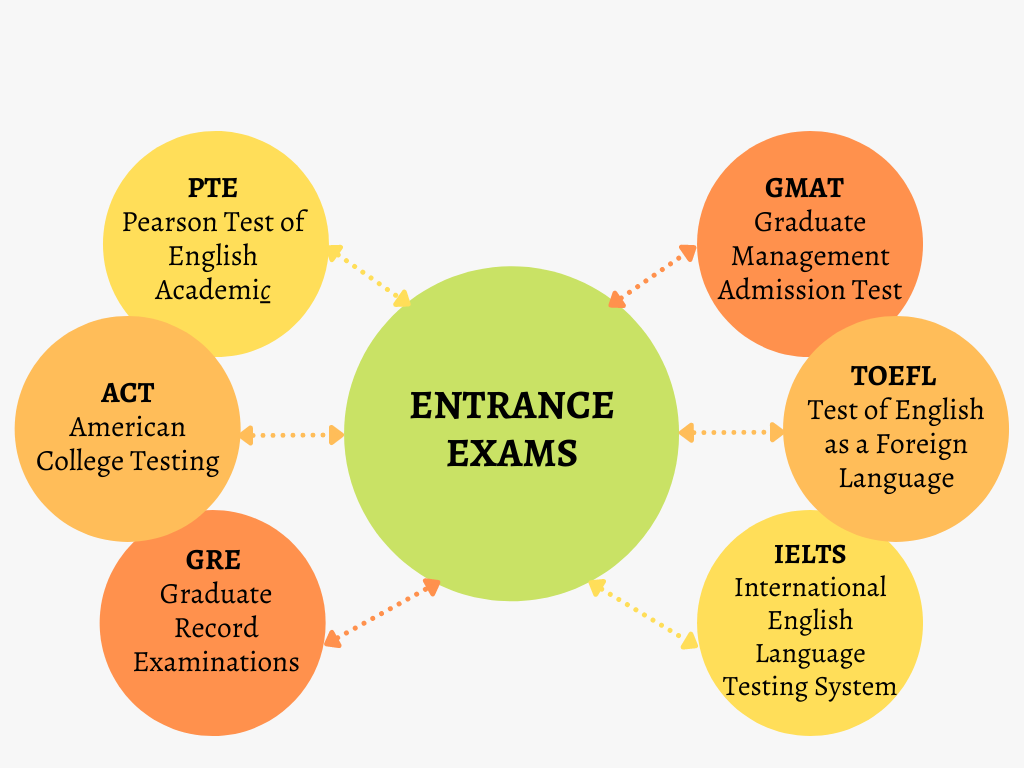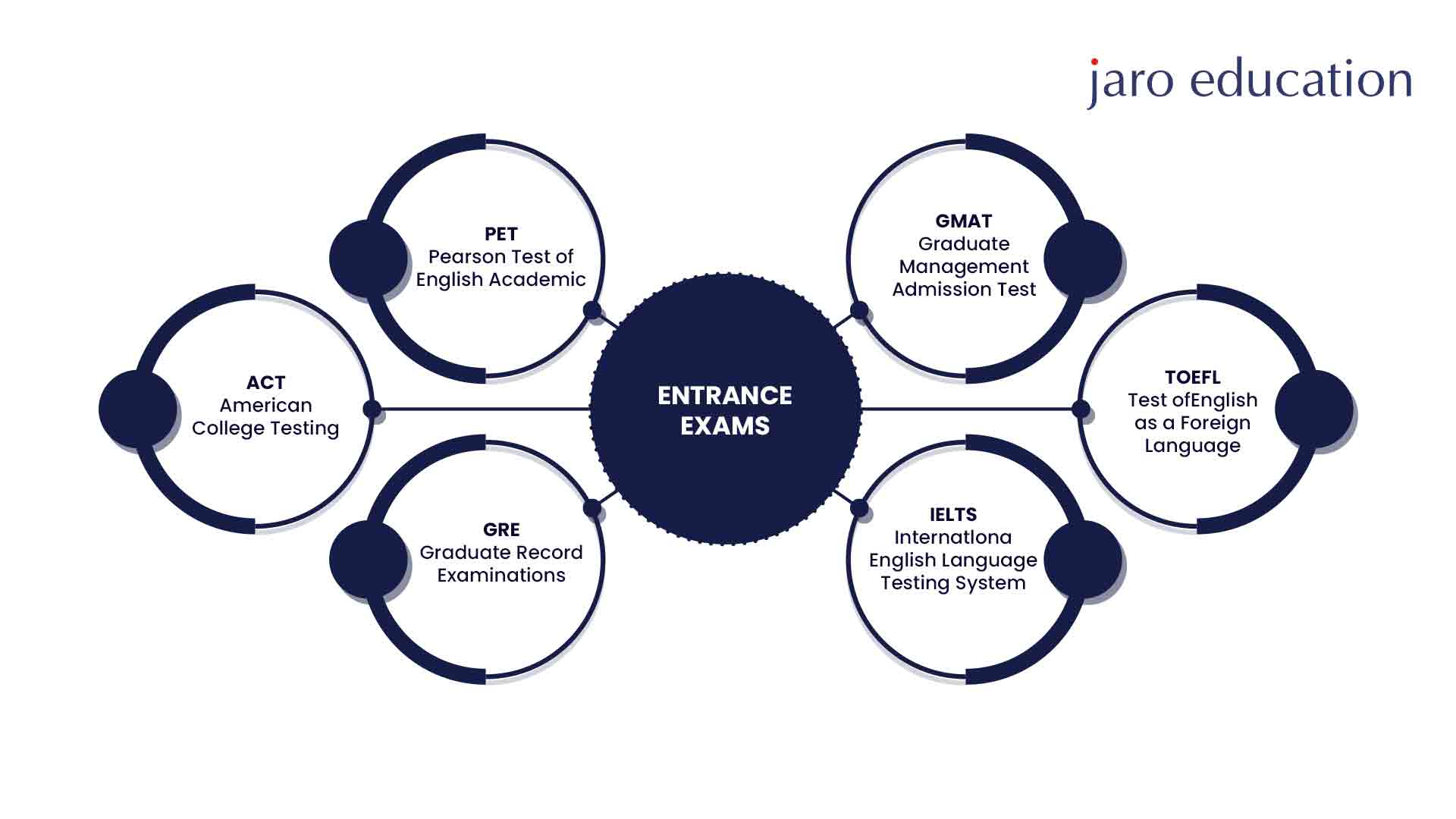
- jaro education
- 20, May 2024
- 10:05 am
In today’s more networked world, with the porosity around the borders increasing and swelling opportunities across the globe for the most ambitious and well-prepared talent, higher education finds large numbers of Indian students. Studying abroad is charming not just because one can go to another country for academic purposes, but charm includes wanting international exposure, an avenue to some of the best institutes worldwide, and a way to broaden one’s horizons through various cultural experiences. In essence, the decision to study abroad is way more than the pursuit of a degree. It is actually an active plunge into another societal context with fresh perspectives and new ways of developing a priceless global mindset at the forefront of a competitive and interconnected job market.
The international journey of education, however, initiates with clearing some entrance examinations that are tailor-made for the requirements of the destination country or institute. These are exams for elite universities and programs to prove the capability of a candidate to be admitted and follow an international academic course in both academic knowledge and language skills.
So, here we are with this all-comprehensive blog post to help Indian students wrap their heads around the nitty-gritty of studying abroad and the top 7 international entrance exams they should consider.

Table of Contents
*azent.com
1. IELTS (International English Language Testing System)
The IELTS (International English Language Testing System) examination, in fact, is one of the accepted proficiency tests for the English language worldwide. It gauges the language competence of persons desiring to study or work where English is used as a language for communication. The test covers four key language skills: listening, reading, writing, and speaking.
IELTS is managed by the British Council working in a joint venture with IDP: IELTS Australia and Cambridge Assessment English. More than 9,000 organizations around the world have recognized the test, ranging from universities to employers, professional bodies, and immigration authorities. There are two types of IELTS tests: Academic and General Training.
The Academic test is for admission to higher education or seeking registration with professional bodies, and the General Training test is normally for migration purposes, seeking entry to Australia, Canada, or the UK, secondary education, training programs, and work experience in an English-speaking environment.
One of the reasons for its popularity is that most universities and institutions, which include the UK, USA, Canada, Australia, and New Zealand, accept IELTS scores. It is also taken as one of the visa conditions, particularly with regard to the proof of English proficiency given by an applicant, in most countries, including the UK and Australia. For IELTS test-takers, they need to understand the test format, grasp the scoring system, and prepare thoroughly across all the four skills. A large number of Internet materials are involved in preparing candidates. They represent tests, courses, and examples of tasks to be carried out.
2. TOEFL (Test of English as a Foreign Language)
The TOEFL (Test of English as a Foreign Language) is the most widely accepted general English language ability test for students who want to enroll in programs taught in English at English-speaking universities. This is globally identified, such as in the United States, Canada, the UK, Australia, and many other countries. Therefore, that makes it very important for an international student to take that step.
TOEFL (Test of English as a Foreign Language) iBT (Internet-Based Test) makes up the most common type of TOEFL with four sections. It has been designed to measure an individual’s ability to communicate in an English-speaking academic environment. Sections in this paper measure critical abilities required for individuals to be successful within an academic set-up in effective communication. It includes:
- Reading: Consists of 3-4 passages from academic texts, followed by questions to assess comprehension.
- Listening: Includes lectures and conversations in an academic setting, with questions to test understanding.
- Speaking: Measures the ability to communicate effectively in English in an academic environment through six tasks.
- Writing: Involves two tasks where you write essay responses based on reading, listening, and listening tasks, and also on an independent topic.
The whole test takes around 4.5 hours, and its 4 sections are scored in a 30-point system. That is, in other words, after taking a TOEFL test, a student can get a maximum of 120 points. Scores can be available within four days after the test, and the TOEFL can be retaken as many times as one would like, given that each is at least 12 days apart from the last (ETS).
In most of these institutions, due to many reasons, the TOEFL iBT has become a preferred choice in evaluating academic English skills properly; in essence, it becomes a very critical step for all non-native English speakers pursuing further studies in an English-speaking country.
3. PTE (Pearson Test of English)
The PTE (Pearson Test of English) Academic is a test of the English language that is academic in nature and is delivered on a computer. It assesses the readiness of a non-English native speaker to take part in a program taught at the university level and given in the English language. Widely accepted throughout Australia, the US, the UK, and other countries, PTE Academic focuses on the real-life English language used in academic environments.
The other three key main parts under test format: Speaking & Writing, Reading, and Listening. The skills range from spoken and conversational English to academic English. This type of assessment is broad in its range, meaning that the test taker is guaranteed practice for just about any sort of scenario or demand that could be found within an English-speaking academic environment.
Test results, usually within five days, are effective in getting people who need their English test results quickly. PTE Academic provides great value to students who want to get assessed for real-world, conversational English language along with their academic English language proficiency. This is what sets PTE apart from other English language tests of an academic-oriented nature, such as IELTS and TOEFL.
4. GMAT (Graduate Management Admission Test)
The Graduate Management Admission Test (GMAT) is a very frequent test and a key step for thousands of candidates admitting to the whole world and, most specifically, to MBA graduate business programs. It is a test of the mentioned abilities, conducted in English, with standard criteria. Accepted globally, a strong GMAT score can easily boost your application and crack wider chances of getting admitted to the elite B-schools, if not the possibilities of scholarship offers.
Over time, the layout of the GMAT examination structure has changed a little, in the direction of better representation of necessary skills for today’s business world. The current GMAT Focus Edition is composed of three major sections:
- Quantitative Reasoning: It covers skills in mathematical and numerical literacy with measures of problem-solving abilities in areas of arithmetic and elementary algebra.
- Verbal Reasoning: This test is designed to measure both your reading comprehension and critical reasoning skills in drawing inferences and conclusions from material provided to you.
- New Section: Data Insights. The next new section will test your ability in interpreting and analyzing data—a skill that is fast gaining importance in the field of business.
The GMAT Focus Edition will take a total of 2 hours and 15 minutes, as it will cover all the important competencies one must exhibit for business school success in a streamlined experience. Other interesting features of the test would be the Question Review & Edit tool, which allows the user to have better control over his or her test answers by reviewing all the answers within each section. In addition, the order of taking sections and when to take an optional break is up to you, just to customize testing according to your preferences and strengths.
Most results are available in 3-5 days. GMAT provides detailed insight into one’s performance and may be used by one and his or her programs to understand whether one is ready for graduate management education. The average GMAT costs about $275 at the test center, but location might play a huge factor in the cost.
Being computer-adaptive simply means certain questions are always adjusted in their level of difficulty based on your performance; in other words, you will be dealing with a personalized test every time you do your stuff, measuring your abilities as accurate. You can take the GMAT as frequently as 16 days, with up to 5 tests within any continuous 12-month period. That means lots of opportunities to really get that score you are looking for.
5. GRE (Graduate Record Examination)
The GRE (Graduate Record Examination) is an admission test to thousands of graduate, business, and law school programs in the United States, Canada, and the world. The test includes verbal, quantitative, and analytical writing aptitude sections. The GRE is designed to report scores for a wide range of graduate and professional programs. It measures abilities developed over a long period of learning that are important to success in a wide variety of graduate and professional school programs.
The overall testing time is close to 1 hour and 58 minutes; it is comprised of five sections. The Analytical Writing section, as is usual, is, in fact, first in order, and it contains one task “Analyze an Issue,” to be completed within 30 minutes. What’s more, the Verbal Reasoning section and the Quantitative Reasoning section have two subsections, with different numbers of questions in each section and different time limits for each section.
In the Verbal Reasoning section, you will be given 18 minutes to solve 12 questions, while in the other sections, each containing 15 questions, you will be given 23 and 23 minutes, respectively. In the Quantitative Reasoning sections, 12 and 15 questions are to be solved in 21 and 26 minutes, respectively.

6. SAT (Scholastic Aptitude Test)
The SAT, administered by the College Board, is one of the standardized tests for college entry in the United States. The test aims to assess school students’ readiness for college by examining skills in evidence-based reading, writing, and math. The structure and content of the SAT will “be changed” in order to better reflect what the test believes to be the skills and knowledge most required for college and career success.
The test is divided into sections that cover Reading, Writing and Language, and Math.
The Math section includes some but not all parts in a calculator-included section. It also has an optional section for the SAT Essay, which some colleges may require. Essentially, it administers a prompt based on which the student is supposed to develop an essay while doing an all-around analysis of the argument that has been given.
Preparation is the key to doing well on the SAT, and the College Board offers many materials, from tests to prep books, for the student preparing to take this test. Get more information on the format of the test, the nature of questions, and get enough practice through authentic SAT questions. As a result, the SAT is a very important step on the path to college for many students; thousands of colleges and universities in the United States and other countries accept it.
7. ACT (American College Testing)
The American College Testing (ACT) is a standard examination that is taken by all American high school students seeking ways of determining the level of readiness and preparedness of the student to cope in an advanced college environment. Developed by ACT Inc. in 1959, ACT has now become one of the most popularly accepted college admission tests in the world, together with the SAT. More than a million students take the ACT each year, obviously underscoring the importance that is attributed to it in college admission.
The major parts that will be tested during the ACT include English, Mathematics, Reading, and Science. The ACT test itself will be organized in the following way:
- English: 75 questions in 45 minutes, focusing on grammar, punctuation, sentence structure, and rhetorical skills.
- Mathematics: 60 questions in 60 minutes, covering algebra, geometry, and trigonometry.
- Reading: 40 questions in 35 minutes, assessing reading comprehension.
- Science: 40 questions, 35 minutes, measuring skills in analyzing, interpreting, evaluating, reasoning, and problem-solving with data.
The optional Writing section involves a 40-minute essay. The ACT, with an optional Writing section, will last 3 hours and 35 minutes in total. Without the optional Writing section, the whole test will take an overall time of 2 hours and 55 minutes. If you decide to take the Writing section, then the overall time for the whole test sums up to 3 hours and 35 minutes.
Scores in the ACT range from 1 to 36, while composite is an average of scores from the four major sections. The Writing section will have a separate score, independent of the composite score and not related to performance in other sections. Each section’s raw score (the number correct) receives a scaled score that ranges within this one, and all the scaled scores are averaged so that a composite score is provided. The average general ACT score is around 21.
Conclusion
The international higher education is replete with opportunities for Indian students who find the foreign pathways to prestigious institutions and the cultural diversity offered by them rather exciting. Studying abroad is more than international exposure flavoring up a resume with some foreign degree; it is the mindset that grows toward successful living in the interdependent world of today.
Preparation for these international entrance exams and an idea of the formats are very important, and students can find useful resources for the same. It gives an excellent opportunity for them to shine on the world academic stage and develop their career in the field of data science through the Advanced Data Science Certificate Program offered by the Rotman School of Management and IITM Pravartak Technology innovation hub of IIT Madras. The program will provide students with advanced skills in data analysis, machine learning, and data visualization, among other capabilities that shall aid them in the data-driven complex world.
Thus, this road starts out with a number of entrance examinations that are made to fit some specific destination countries or institutions and present the academic and language abilities of prospective candidates. Preparation is a key to success, and students can find resources to familiarize themselves with the formats of these exams. Making the students prepare and understand the relevance of these examinations and devising a proper strategy of preparation would be able to help students open vistas of academic excellence and development on the global front.









